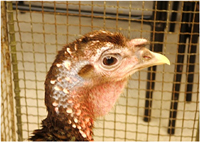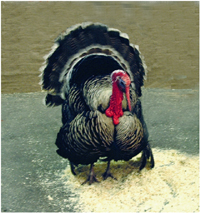Turkeys Turkeys are enjoying a revival in numbers due to their personalities and choice of colours, ease of production and suitability for organic systems. It is the dedicated breeders who exhibit, however, as these large birds take some transporting. They are fascinating and entertaining creatures. The turkey was first domesticated in Mexico by the Aztec Indians as early as 1000 AD and the first arrival in Europe of these birds was in 1526. The origin of the name is shrouded in different theories, but the Aztec name for them is toto, some place names in Mexico still containing this. The first turkeys to be exhibited in the UK was in 1845, with a Standard appearing in the first Book of Standards in 1865.
Commercial turkeys have been selected for rate of growth and muscle mass, which gives them a waddling walk (the bronze record being 96lb (43.5kg)). These birds have been termed dimple or broad breasted and would be the sort of turkey seen in supermarkets. The coloured varieties, however, maintain the wild shape and activity and are known as high breasted. The meat tends to be superior in flavour in the high breasted birds as they are generally grown outside on grass and only the high-breasted birds are exhibited, not commercial meat breeds.
The general characteristics of all colours are that the head should be long, broad and carunculated (enlarged knobbly areas of skin) with an extensible snood in the centre of the forehead, much larger in the stags. The beak is strong and curved and the eyes are bold and prominent. The throat wattle is large and pendant, but larger in the stag. The hens have sparse feathers on top of their heads and the colour of the bare skin in both sexes can range from white to red to blue, depending on mood. The body is long, deep and well-rounded with strong and large wings and a long tail containing 18 feathers. The legs are stout and strong with long claws on the toes. When displaying, the stags hold their necks towards their upright tails with the breast puffed out and make a “poomph” noise by displacing air. Sometimes a hen will display if agitated and it is amusing to see the young toy-like poults practising their display technique. The stags and sometimes older hens, develop a tassel which is composed of thick, coarse, hair-like feathers growing in a bunch from the top of the breast. This increases in length with the age of the bird.
Handling
All turkeys are immensely strong which can make handling quite difficult, even if they have been used to being handled from dayold. Use a strong fishing landing net to catch them or drive them into a corner, but beware they do not fly onto something unreachable. Restrain the bird loosely around the neck before putting your other hand and arm over its back, confining its wings. Then slide the first hand underneath from the front, clasping its legs firmly around both shanks. Transfer it to your forearm, the other hand now on its back and its head pointing behind you with the mucky end pointing away from you. Unless the wings are restrained when carrying them, a nasty thick lip can ensue, but they very rarely bite. Turkey muck is particularly pungent, so you really don’t need it in your pocket. If you first come across a turkey in a box, firmly grasp it around the body and wings to lift it out, then slide one hand underneath to secure the legs. Beware the strong claws. Classification of BreedsLight BreedsBritish White: the plumage is pure white in both sexes with a black tassel. Eyes are dark blue with a white beak and pink legs. Rarely seen at shows, but the commercial bird is white and much heavier. The poults are pure white. Weights: stag 9.07-9.97kg (20-22lb), hen 4.5-5.44kg (10-12lb). Buff: cinnamon-brown is the colour of these throughout the body of both sexes and there is no black banding anywhere or white on the breast of the hen. The primaries and secondaries are white and the tail is deep cinnamon-brown edged with white. The eyes are dark and the legs pink. The poults are pale brown. Weights: stag 9.97-12.7kg (22-28lb), hen 5.44-8.16kg (12-18lb). Pied (Cröllwitzer): the neck is white with narrow black banding and the body feathers are white with a black band edged with white throughout, the black tending to become broader towards the tail. The primaries are white with a black edge and the tail is white with a distinct black band followed by white at the edge. The eyes are brown and the legs horn-coloured. The poults are white, the black markings appearing as they get older. Weights: stag 9.07-9.97kg (20-22lb), hen 4.5-5.44kg (10-12lb). Norfolk Black: these should be a dense, glossy black throughout. There should be no white anywhere nor slight bronze bands in the tail – the less of this, the better. The eyes and legs are dark and the poults are black with a white face and some white on the underside. Weights: stag 11.35kg (25lb), hen 5.9-6.8kg (13-15lb).
Slate: getting the slatey blue an even shade throughout is challenging as brown tends to creep in, especially in the tail. The blue can be a dark or light shade as long as it is even, but darker birds are preferred at the shows. Some strains tend to black spots in the feathers, but the less of this, the better. The eyes are dark and the legs slate. The poults are pale grey. Weights: stag 9.97-11.33kg (22-25lb), hen 6.35-8.16kg (14-18lb). Nebraskan Spotted: the basic body colour is white with irregular red and black flecks or spots with white wings and tail and an indistinct cream band near the edge of it. The poults are cream and gradually acquire the other colours as they get older. Weights: stag 8.16-11.33kg (18-25lb), hen 6.35-8.16kg (14-18lb). There are probably very few of these in the UK now, having been superceded by the Harvey Speckled, accepted to the Standard in 2016. (visit www.turkeyclub.org.uk for further details) Lavender: the colour should be a pale, even shade of blue throughout with no brown or black. Popular, but not easy to obtain. Weights: stag 9.07-9.97kg (20-22lb), hen 4.5-5.44kg (10-12lb). Heavy BreedsBourbon Red: the stag’s head and neck are brownish-red. The rest of the body is rich, dark, brownish-red, each feather with a narrow black edging. The wings are white and the tail is white with an indistinct red bar. The hen is the same colour as the stag but with no black edging to the feathers and narrow white edging on the breast feathers. The eyes are brown with horn-coloured beak and legs. The poults are brownish. Weights: stag 9.97-12.7kg (22-28lb), hen 5.44-8.16kg (12-18lb). Bronze: the body feathers are black with a broad metallic bronze band, giving the overall effect of solid metallic bronze. The hen has fine white banding on her breast. The primaries are black with distinct white barring and the secondaries are less sharply marked. The tail feathers are black with brown barring, ending in a broad bronze band followed by a broad white band, each change of colour to be as distinct as possible. The eyes are dark, the beak horn and the legs dark. The poults are brown and dark brown striped. Weights: stag 13.6-18.14kg (30-40lb), hen 8.16-11.79kg (18-26lb). Narragansett: this is patterned like the Bronze but the body colour is steel grey with a narrow black band on each feather, becoming solid glossy black on the back then each feather banded with steel grey above the tail. The primaries and secondaries are distinctly barred with black and white and the tail is black barred with tan, ending in a black band edged with a broad band of pale steel grey. There should be no bronze cast in the black. Weights: stag 13.6kg (30lb), hen 8.16kg (18lb).
Turkeys are insatiably curious and given the chance, will get into all sorts of mischief: they have strong hooligan tendencies. Their boredom threshold is low and if there is nothing else to do, they will pick on one of their own number and have a mugging session. They are very vocal – a poult stuck somewhere will shout “weepe, weepe” for hours – and the stags will always answer you if you call to them or imitate the noise of the hens, a “keow, keow” being the most successful, and the alarm call is a “putt, putt”, given if a strange noise is heard or a stranger spotted. Small children love the noise competition! Hen turkeys lay speckled eggs which are larger than hen eggs but have similar eating qualities. Egg production ranges from 50-80 depending on the breed and eggs are laid only in the spring and summer. Turkeys need housing similar to chickens with low perches and a large pophole. They eat quite a lot of grass and will weed an area of docks and plantains with relish. However, turkeys need commercial turkey feed, not chicken feed, in order to maintain their health and suitable growth rates, plus grit for digestion of whole wheat. Turkey hens fly well, particularly when looking for a nesting site, so a clipped wing (see Chickens) is useful here. Young stags can fly a bit, but they get more sedentary as they get heavier. However, a one metre (three foot) high fence is easily jumped/flapped onto by stags of any age. All turkeys love to perch at night when roosting and if not given a perch will get up onto inappropriate heights such as roofs. Their flock instinct is powerful, which makes them good guards in daylight, but they do not see well in the dark, unlike waterfowl. This flocking makes them easy to move by driving if done slowly. BreedingTurkeys choose their mates in February, so need to be separated in to specific breeds earlier in the year than other poultry in order to obtain purity.
Otherwise, similar to chickens including de-broodifying. Using a turkey breeder ration six weeks before eggs are incubated will ensure the strongest poults. Stags take a long time to mate and can damage the back and flank of the hen, a breeding saddle can be used for her protection. Hen turkeys will incubate and hatch their own eggs and are quite good mothers, but need confining as they tend to walk the poults through long wet grass with disastrous results. The incubation time is 28 days and it is best to rear turkeys separately from other poultry species. Health & DiseasePositive signs of health in turkeys
Dry ground, as in other poultry, helps to reduce disease. Turkeys can suffer from mycoplasma (like chickens) and need worming with Flubenvet 3-4 times a year. The potentially fatal disease, blackhead (bright yellow droppings), is caused by a parasite that has part of its life in a chicken intestinal worm, so keeping chickens and turkeys regularly wormed is good welfare. |









